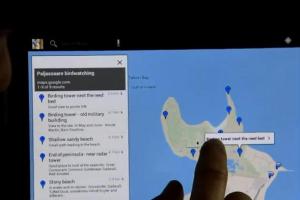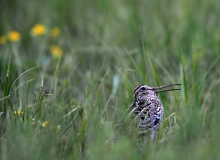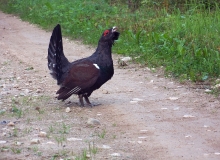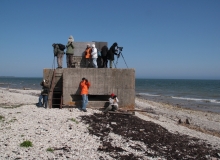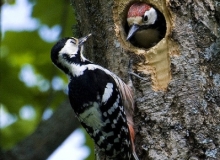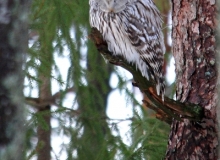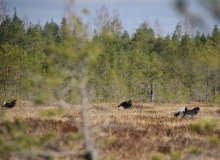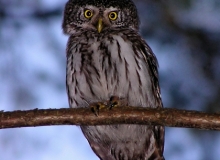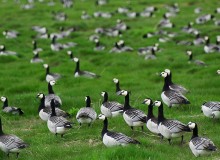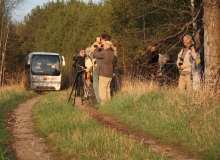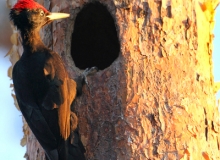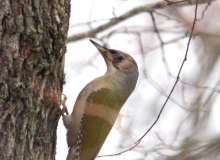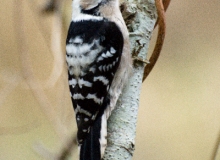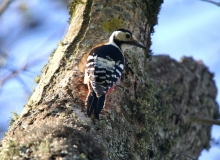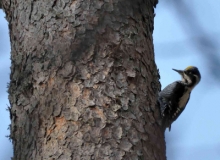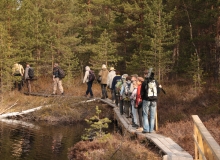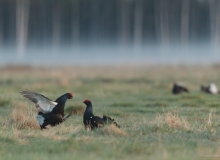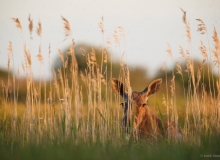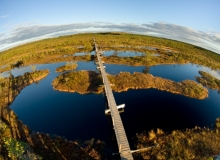WHAT IS A SELF-GUIDED TOUR?
Natourest is one of the first wildlife and birding tour companies to offer this innovative nature tour type. A self-guided tour (SGT) with a smart device is designed for active and independent people appreciating privacy and flexibility.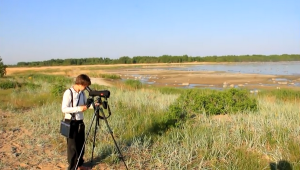 SGT offers the opportunity to visit the same nature areas as on our guided trips. With SGT, you will be your own guide and you can decide where to go and how much time to you want to spend at a specific location. By choosing our SGT you don’t have to do the research on finding the best birding areas in Estonia. That’s what we have already done for you. The only thing you have to do is choose among the suggested locations.
All locations are thoroughly chosen and visited annually by our guides to ensure you will have the updated information. Most people choose for one of our ready-made self-guided itineraries but we can modify any of our tours to suit your needs.
SGT offers the opportunity to visit the same nature areas as on our guided trips. With SGT, you will be your own guide and you can decide where to go and how much time to you want to spend at a specific location. By choosing our SGT you don’t have to do the research on finding the best birding areas in Estonia. That’s what we have already done for you. The only thing you have to do is choose among the suggested locations.
All locations are thoroughly chosen and visited annually by our guides to ensure you will have the updated information. Most people choose for one of our ready-made self-guided itineraries but we can modify any of our tours to suit your needs.
HOW?
On the self-guided tour, you will have a Smart Device (tablet PC or smartphone) with 4G internet connection and GPS geolocation, a special app (suitable for iOS and Android) with an online map with locations and detailed instructions. You will also receive a suggested itinerary for all your touring days. A paper map is also provided as a backup.
You only have to download the Loquiz app from Google Play Store or App Store. In case you’ll travel with your own smart device and there’s no need to meet our representative at the airport, we will send you a unique username and password shortly before your arrival. Then you
While you are on the tour, Google Maps navigator leads you the way to the best birding places. Also, you get the information where to park a car, where is the next observation tower or an interesting hiking trail, what kind of birds you most probably see there and where to look for them. The app (Loquiz) we use for the SGT works on both iOS and Android devices.
The self-guided tour includes:
- hotel bookings
- car rental
- Natourest representative meeting you at the Tallinn airport (if you receive the tablet from us)
- smart device (tablet) with tour map during the tour
- paperback atlas of Estonia
- tour description with daily route suggestions.
BENEFITS:
SGT offers opportunities missed when traveling with a group – flexibility, privacy, and favorable price with the support from our office.
1) Flexibility and privacy
-You travel on the dates that are best for you and your group
-We give itinerary recommendations for all the travel days but you decide at what pace and order you visit the best wildlife watching locations.
-You travel with your own friends or/and family
-Your route is well planned by our experienced guides
-All accommodations are chosen in the middle or close to the best wilderness areas, you have a choice of accommodation options to suit your budget
2) Favorable price
-Prices vary based upon your level of accommodations and duration of the tour. By default, we will make the quote and book accommodations with WC and shower inside the room.
-For example, Steller’s Eiders weekend self-guided 4-day short break is 450 euros per person. The approximate cost of a guided short break would be 630 euros per person.
3) Support from expert
-Upon your arrival, you will be met by a representative of Natourest for a short introduction and tour materials.
-If you need assistance during the trip you will have phone support 24/7
WHEN?
The best months for bird-watching and mammal watching in Estonia are May and September- October. The first half of April is the best time to come to Estonia to see both the Steller’s Eider and also observe the activities of owls, woodpeckers, and grouses.
How to be sure you would enjoy a self-guided trip?
- You are comfortable reading a map and following road signs. To really enjoy a self-guided trip, you should like discovering surroundings on your own hand and have an open mind. So if you do miss a turn and have to backtrack you will be okay doing so. After all, the most memorable travel includes some unplanned adventures!
- You have some intuition about using technology. Just awareness of when to load batteries and how to turn the device on is good enough.
- You prefer to take time to notice details in nature yourself without someone pointing out species and have the patience to observe.
- You value having a personal trip schedule.
AVAILABLE SELF-GUIDED TOURS:
1. Steller’s Eider weekend- self guided short break, 4 days.
About 2000 Steller´s Eiders (Polysticta stelleri) winter in West-Estonian coastal waters. In Early spring they come closer to shore and are easier to see. At the same time woodpeckers, owls and grouses are getting more active. Capercaillie, Black Grouse, and Hazel Grouse are lekking. Owls are vocally defending their breeding territories and woodpeckers are drumming. The best time for sighting all this natural life is at the end of March and the first part of April. Read more…
2. 8 best wilderness areas in Estonia
If you want to do the planning on your own and need only know-how map with locations then contact us info@natourest.ee about Estonian wilderness areas. It is a package of 8 best wilderness areas in Estonia with locations of target species habitats and instructions on how to spot them better.
3. Estonian birds and mammals, 8 days self-guided tour.
Estonia has about 10 000 Elk, 800 Brown bears, 200 Grey Wolves, 500 Lynxes, lots of roe deer, foxes, raccoon dogs. It’s also the best place in Northern Europe for mammal- and bird-watching. This self-guided tour will lead you from N-E Estonia – where you’ll get close-up views from a Brown Bear hide to world-famous Matsalu NP on the western coast. Read more..
Feel free to ask any questions or book your holiday- please contact us: info@natourest.ee or by phone:
+372 5622 5943
Julia and Daniel made at first a group tour organised by Natourest and Birdingtours, and subsequently a Tailor-Made Self-Guided Tour in September 2018.
Karl had already summarized our group trip together on the last evening. There is hardly anything to add – it was just great!
Our subsequent private tour was beautiful as well.
We actually visited all the points that you both recommended us and had there again great wildlife observations.
After Tallinn, we made a stop in Marimetsa peat bog, on the way to Saaremaa, and made a hike. A really beautiful and varied hike, which included a hazel grouse sighting and a swim in a bog pool.
On Saaremaa, we were by the crooked lighthouse, at the northern tip and then drove also to the southwestern tip(with many stops). On Saaremaa we observed, among others: „a city deer“, a doe with a fawn, Long-tailed Duck, a great number o Barnacle Geese with a few Bar-headed Geese, Loons and an Elk.
After that, we were at Pikla Birdhouse – even though the weather was so-so, the place itself was really nice. From there we drove to Soomaa and on the second day to Nigula Bog, with a stop at Rannametsa Bog. It was raining a bit in Nigula Bog, which did not bother us much, as we found a shelter on about half of the way. In Soomaa we did practically all the tours from the tablet. Among other, we had observations of black grouse, a crazy Nutcracker, a Golden Eagle (passing by, only 20m away!).
At Pikla Birdhouse, we saw Bearded tits, White-tailed Eagle, and on the last morning in the bog, a sunrise with fog and no wind, absolute class!
On our way to the bear hide (again with stop and hike in Soomaa NP) a Capercaillie stood directly on the roadside. We almost did not believe our eyes! The bear hide was great again! A total of 2 or 3 different bears came again really early (about 17:00 PM) in good light conditions, and even from the west side of the hide, it came out when the light conditions were still good. One of the bears was extremely relaxed and laid down several times next to the hidden bait and ate in peace. The night was bitterly cold – in the morning, there was ice on the car (we probably caught the flu from there).
In the morning, on our way back from the hide to the car, we saw a Hazel Grouse (flying from the edge of the road) and Capercaillie (directly on the way in about 50m distance from the barrier chain). Afterwards, we also saw Black Grouse from the car – thus 3 grouse species within 2 hours – just crazy!
At the end in Palmse, we both had caught a cold. Therefore, we had to take it a little easier there. Therefore, we could not stay for the third planned night in the bear hide. Thanks again to Peep for the uncomplicated cancellation of the bear hide.
In the north, we were again at the points where we were already during the group tour. It was partly very windy and stormy. At the primeval forest trail, old spruce fell down about 10m away from us. (Lucky!). Therefore, we finished the trail a bit faster than usual (in addition, there were 2 more really loud crash-noises nearby). We hiked to Majakivi on the last day before the departure – also a very nice trail!
During the last part of our trip, we had sightings of Black Woodpecker, Oystercatcher (Purekarri – the middle finger of Lahemaa) and flocks of Brent Geese, Eurasia Wigeons and Velvet Scoters. So, that was our short summary.
Thanks again to you for the great impressions on the group trip and the great compilation of the private tour. Everything went very well and we really enjoyed it. We will come back and recommend both of them to other!
“Thank you, thank you, thank you … the trip was the coolest!”
many Greetings
Julia and Daniel
Tony and his group were in Estonia 8-12th of May 2013
The trip went very well. In all we saw or heard about 151 or maybe a couple more. A few mammals too. The self-guided map worked very well. We could put the co-ordinates straights into a sat-nav and it took us perfectly to the locations. White-backed woodpecker was hard, in the end, 5 of us saw it, but two of the group were chasing a tawny owl then searching for a corncrake so missed it. We’re already thinking about next year, maybe an earlier one for Seller’s Eider and more woodpeckers/owls. Or late May for Great Snipe etc.
Tony
Andrew was in Estonia at the end of March 2013
I managed to see a hawk owl near to Virtsu on a forest road. I was surprised at the scarcity of birds during our time in Estonia, I assume that it was due to winter weather. We manage to see ca 240 Steller’s Eiders at Uudenpanga bay, several groups of snow buntings and Great Grey Shrikes, despite searching suitable areas no White-backed Woodpeckers or Three-toed Woodpeckers, we did see Grey Headed and black though. We managed to see Hazel, Black grouse and Capercaillie. On our drive back to Tallinn airport, we saw our only nutcrackers at the roadside along with several blackbirds presumably northbound migrants!
We enjoyed our visit and would like to return when the weather is a little kinder!
Andrew
Mike was in Estonia the beginning of June 2012
Having attended a lecture on Estonia at the Bird Fair a few years ago, we knew the country boasted a mouthwatering list of northern and eastern special birds. We did not want to be on an organised tour, but having never visited the country before needed some help in finding good sites to visit. David Gosney`s “Finding Birds in Estonia” we found to be a useful startpoint. The GPS provided by Natourest (www.natourest.ee) was preprogrammed with a lot more sites including specific places for scarce breeding birds like White-backed Woodpecker and Ural Owl. We are both technophobes, but after a little tuition and some practice, found the GPS system (TAB and Google Maps) relatively easy to use and of great value in getting to sites, that in some cases were off-road down forest tracks. We found Estonians to be very friendly, and most people speak English well. The road signage is good, and outside of Tallinn the roads are empty of traffic. We found the accommodation to be of a good standard and the food very tasty. There are a lot of National Parks and Reserves with a very good infrastructure of bird-towers, boardwalks and toilets. With a lot of wet forest, bogs and mires, there are also a lot of mosquitos, but regular application of deet, did keep the number of bites received down. Our holiday was very enjoyable, and we certainly hope to visit again.
Mike from England
The maps are good for the overview, the big picture. But it was good you sent the text with the coordinates too, it was very useful. It’s much easier to use the GPS this way, and the GPS is needed because the internet connection is not so good in some of the forests.
Mads from Denmark
PS. On the tablet, you can see our first version of our SGT. Now we have switched to an app-based map, making the whole package quicker and much more personalised. Hopefully, we will soon be out with a new video:
Below is a small sample, a self-guided bird watching tour in Tallinn, Paljassaare. The other self-guided tours are built similarly. The first bigger change in our tours was moving on from Google My Maps system to a much more convenient and visually better-built online map in 2018. In 2020, we made an even bigger change and switched to an app developed in Estonia – Loquiz. Communicating directly with the developers, we can now offer tours, which are even more personalized and visually On the map are displayed watching towers, birding and mammal-watching spots, when to spot them, info about nature trails, parking, recommended restaurants, and accommodations.
The recommended route for Paljassaare self-guided tour:
Paljassaare ist the best birdwatching area near Estonia’s capital, Tallinn. This NATURA 2000 site is just a 15-20 minute drive from the city center.
The tour takes a couple of hours up to half of the day. The area is a mix of in reed-beds and stony coastline providing habitats for different bird species. It is not a good spot to observe mass migration but it is excellent when you like to spot a variety of species. Over 100 species are definite or probable breeding birds in the area and there are 231 birds in the Paljassaare bird list.
All of the paths can be passed on foot and usually, rubber boots are not needed. There are 2 bird watching towers, a wooden (1) and a white brick one (2). The white brick tower was in the past Soviet navy searchlight garage. These types of buildings are found in many places along the Estonian coast, only this one here is reconstructed into a birding tower. It’s a 3-story building, where you can also find shelter from the rain.
If you only have time to visit one location in Paljassaare, then the wooden bird watching tower (1) should be the first choice. The tower is next to the reedbeds and the southern lake. There’s also a scrub-land by the tower and an open brownfield in the south, which attracts raptors.
Multiple information boards are along the trail. During the breeding season 01. May – 31. July, people should stay on the paths and not wander around in the bushes, reed-beds, or along the coastline.
List of species that can be seen:
Spring, April, and May:
Autumn, September, and October:
Ringed Plover, Little Plover, Common Redshank, Mute Swan, Common Eider. During the migration Bewick’s and Whooper Swans.
On sea and on stones- Eurasian Oystercatcher, Common Shelduck, Goosander, Gadwall, Common Goldeneye, different gulls, Great Cormorant, Tufted Duck, sometimes Velvet Scoter, Common Eider, Red-breasted Merganser, Common Scoter.
In bushes- Yellow Wagtail, Common Cuckoo.
In reedbed- Grey Heron, Tits, Reed Bunting, Eurasian Marsh Harrier.
During autumn migration- geese and Barnacle Goose.
Winter Long-tailed Duck, Common Eider, Great Crested Grebe, Red-necked Grebe, Black-headed Gull. Flocks of Common Goldeneye and Long-tailed Duck. In bushes- Great Grey Shrike, Great Reed Warbler, Sedge Warbler, Great Bittern.
Book a tour with us: info@natourest.ee or by phone: +372 5622 5943
Book a tour with us: info@natourest.ee or by phone: +372 5622 5943
Choose one of the tours
AVAILABLE SELF-GUIDED TOURS:
1. Steller’s Eider weekend- self-guided short break, 4 days
About 2000 Steller´s Eiders winter in West-Estonian coastal waters. In Early spring they come closer to shore and are easier to see. At the same time woodpeckers, owls and grouses are getting active. Capercaillie, Black Grouse and Hazel Hen are lekking. Owls are breeding and aggressively defend their territories. Woodpeckers are drumming. The best time for sighting all this natural life is from 1 of March until 15 of April. Price per person in a 2 person group is 450 euros. Read more…
2. The know-how map only.
In case you want to do the planning and booking on your own and just need a good overview of the possibilities, then contact us: info@natourest.ee and ask just for the know-how map about the 8 best Estonian wilderness areas. The online map includes 8 best birding areas in Estonia with locations of target species habitats and instructions on how to spot them better. Variety of habitats in short driving distances make Estonia one of the best destinations for self-guided tours in Europe. The know-how about the 8 best Estonian wilderness areas is 99 euros and the know-how for the Steller’s-Eider weekend – a self-guided short break tour is 69 euros.
3. Estonian birds and mammals, 8 days self-guided tour.
Estonia has about 10 000 Elk, 700 Brown Bears, 200 Wolves, 400 Lynx, a great number of Roe Deer, Red Foxes, Raccoon Dogs. It’s also the best place in Northern Europe for mammal- and bird watching. This self-guided tour will lead you from N-E Estonia – where you’ll get close-up views from a brown bear hide to world-famous Matsalu NP on the western coast. Read more…
Book a tour with us: info@natourest.ee or by phone: +372 5622 5943
Natourest is a travel company registered with the Estonian Ministry of Economic Affairs and Communications and meets all the requirements set by the European Package Travel Directive. This means that when you book a tour through Natourest, your legal and financial rights are guaranteed by the state of Estonia. Read more about the terms and conditions.






